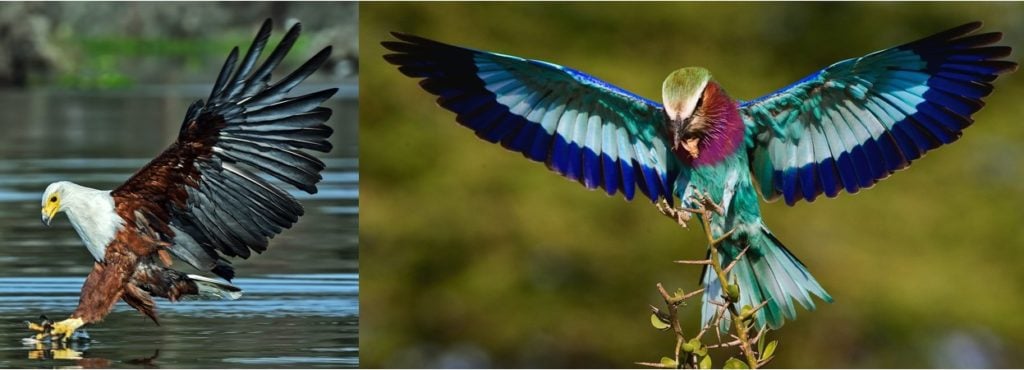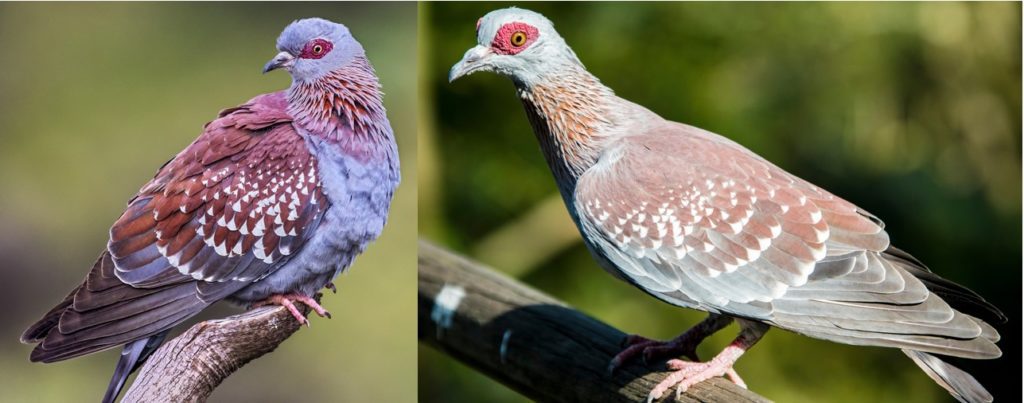5 COMMON Birds Found in Mauritania! (2025)
Are you trying to identify a bird found in Mauritania?

Some of the wildest and most colorful birds you could imagine are found here. From gigantic, flightless birds to colorful showstoppers, there’s something to catch everyone’s attention!
Due to the sheer number of species, there was no way to include every bird in Mauritania in this article. So instead, I tried to focus on the birds that are most regularly seen and observed.
5 COMMON types of birds in Mauritania!
#1. Abyssinian Roller
- Coracias abyssinicus

Identifying Characteristics:
- Adults are 28–30 cm (11–12 in) long.
- The butterscotch brown back and face contrast sharply with its otherwise brilliant blue plumage.
- They have two unusually long tail feathers that look like streamers in flight.
The Abyssinian Roller is an unmistakably beautiful bird in Mauritania!
However, its appearance is just one of its many incredible traits. For example, check out their attack pattern, which is how they earned their name. They tumble and roll as they try to catch escaping prey.
Abyssinian Rollers fly through forests decimated by fire, looking for disturbed rodents, snakes, invertebrates, and reptiles to hunt. They’re also aggressive at defending their territory. They juke and somersault, dive-bombing humans or other threats.
Although unrelated to corvids, these flashy birds make a crow-like sound of “GawwwK” or a screechy “Arrrg.” These mimicking sounds are deliberately intimidating, and this fearless species has the personality to back them up. LISTEN BELOW!
#2. Common Hoopoe
- Upupa epops

Identifying Characteristics:
- Adults are 25–32 cm (9.8–12.6 in) long with a wingspan of 44–48 cm (17–19 in).
- Its coloring is cinnamon-brown on the head and body, with black and white barred wings.
- The head is adorned with a crest of brown feathers tipped in black.
Look for the Common Hoopoe in rural gardens, cities, plantations, savannas, and grasslands. They often spend time near piles of rotting leaves or a fallen log where insects, grubs, and worms will use it as a habitat. It’s like a buffet for the Hoopoe!
This unusual-looking bird has a variety of defensive tactics. Its movable crest is used for advertising and intimidating potential predators and rival Hoopoes. If that doesn’t work, this species is ready for a fight! They use their strong head and neck muscles to gouge their long, pointed beaks into opponents’ eyes, which can blind them.
In addition to their fighting skill and intimidating looks, they produce a substance that smells of rotting meat. They cover themselves and their eggs with the substance to warn away predators. Nestlings even have their own scent gland that makes them unappetizing to predators.
#3. Lesser Flamingo
- Phoeniconaias minor

Identifying Characteristics:
- Adults stand 80-90 cm (31-35 in) with a wingspan of 90-105 cm (35-41 in).
- Pinkish-white plumage, with bright pink legs and eye rings.
- These recognizable birds stand tall on very thin legs and have long, curved necks.
This fascinating species is impossible to confuse with any other bird in Mauritania!
Have you ever wondered why Flamingos are pink? Interestingly, their primary food source is Spirulina algae, which contains photosynthetic pigments that turn the birds pink.
Unfortunately, their bright coloring and relatively large size make them a target for many predators. Common culprits are big cats, eagles, pelicans, foxes, jackals, hyenas, vultures, and baboons. To protect themselves and their young, they form gigantic flocks called crèches. Here, babies can number up to 100,000 individuals watched over by several adults.
Lesser Flamingos are among the most successful species in their family, but that doesn’t mean they aren’t in trouble. On the international scale, they are listed as “Near Threatened” because of habitat loss, human land development, limited breeding sites, and heavy metal poisoning in some lakes.
#4. Speckled Pigeon
- Columba guinea

Identifying Characteristics:
- Adults grow up to 41 cm (16 in) long.
- Their coloring is slate gray overall, with rusty wings and white tips on the flight feathers.
- They have a ring of red skin around the eye, giving them a wide-eyed look.
It’s not uncommon for hundreds of Speckled Pigeons to form a flock and inhabit the exterior of large human structures. They’re the primary food source for birds of prey that live in large cities.
Although their shape and behavior are similar to typical urban rock pigeons, Speckled Pigeons are much larger. This species is the largest pigeon in Mauritania at nearly 41 cm (16 inches) long.
Even if the Speckled Pigeon’s call is understated and melodic, it can be overwhelming when hundreds are singing at once. It sounds like “OooOOOuu” repeated a dozen times or more in a row.

#5. White-Throated Bee Eater
- Merops albicollis

Identifying Characteristics:
- Adults are 19–21 cm (7.5-8.5 in) long, with males gaining an additional 12 cm (5 in) from their tail streamers.
- Look for this species’ white throat and white eyebrow on either side of its black eye stripe to differentiate it from other Bee Eaters.
- Their coloring is bright green to white on the belly with a pale blue rump, a black collar underlined in turquoise, and bright yellow-orange on the back of the head.
White-throated Bee Eaters congregate in large groups, which protects them from predators. They also raise their young communally, sharing the duties of protecting nests and bringing food to nestlings.
Like others of their family, White-throated Bee Eaters eat hornets, wasps, and bees, catching them in mid-flight by leaping from a low perch. Before they eat them, however, they remove their prey’s stinger by jamming it into a hard surface several times to extract it. That’s a straightforward way to make sure your meal is safe to eat!
This species has a dry, high-pitched, rattling call.

Do you need help identifying birds in Africa?
These books will provide you with much more information!
Which of these birds in Mauritania have you seen before?
Leave a comment below!






